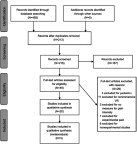Virtual reality as an analgesic for acute and chronic pain in adults: a systematic review and meta-analysis
- PMID: 31308733
- PMCID: PMC6613199
- DOI: 10.2147/JPR.S200498
Virtual reality as an analgesic for acute and chronic pain in adults: a systematic review and meta-analysis
Abstract
Background: Previous studies have shown that virtual reality (VR) is effective in reducing acute and chronic pain both in adults and in children. Given the emergence of new VR technology, and the growing body of research surrounding VR and pain management, an updated systematic review is warranted. Purpose: The purpose of this systematic review is to compare the effectiveness of VR in reducing acute and chronic pain in adults. Data Sources: A search was conducted in three databases (PubMed, CINAHL, Trip) using standardized search terms. Study Selection: Twenty experimental and quasi-experimental trials published between January 2007 and December 2018 were included based on prespecified inclusion and exclusion criteria. Pain intensity was the primary outcome. Data Extraction: We extracted data and appraised the quality of articles using either the PEDro or Modified Downs and Black risk of bias tools. Data Synthesis: The majority of studies supported the use of VR to reduce acute pain both during the procedure and immediately after. Numerous studies found VR reduced chronic pain during VR exposure but there is insufficient evidence to support lasting analgesia. There was considerable variability in patient population, pain condition and dosage of VR exposure. Limitations: Due to heterogeneity, we were unable to perform meta-analyses for all study populations and pain conditions. Conclusions: VR is an effective treatment for reducing acute pain. There is some research that suggests VR can reduce chronic pain during the intervention; however, more evidence is needed to conclude that VR is effective for lasting reductions in chronic pain.
Keywords: acute; adult; analgesia; chronic; pain management; virtual reality.
Conflict of interest statement
The authors report no conflicts of interest in this work.
Figures
References
-
- Teater D The psychological and physical side effects of pain medications. 2014. Available from: http://safety.nsc.org/sideeffects. Accessed September25, 2018.
-
- Sutherland S Meeting report: virtual reality pain 2016 | pain research forum. 2016. Available from: https://www.painresearchforum.org/news/74439-meeting-report-virtual-real.... Accessed September25, 2018.
-
- Greenleaf W How virtual and augmented reality will change the way we shop | techno FAQ. Available from: https://www.slideshare.net/waltergreenleaf/how-virtual-and-augmented-rea.... Accessed September25, 2018.
-
- Hoffman HG, Doctor JN, Patterson DR, Carrougher GJ, Furness TA. Virtual reality as an adjunctive pain control during burn wound care in adolescent patients. Pain. 2000;85(1–2):305–309. - PubMed
Publication types
LinkOut - more resources
Full Text Sources
Medical



